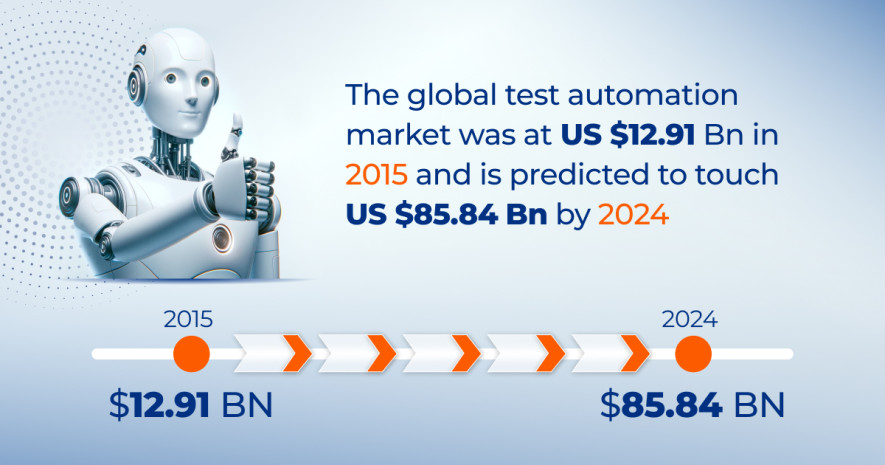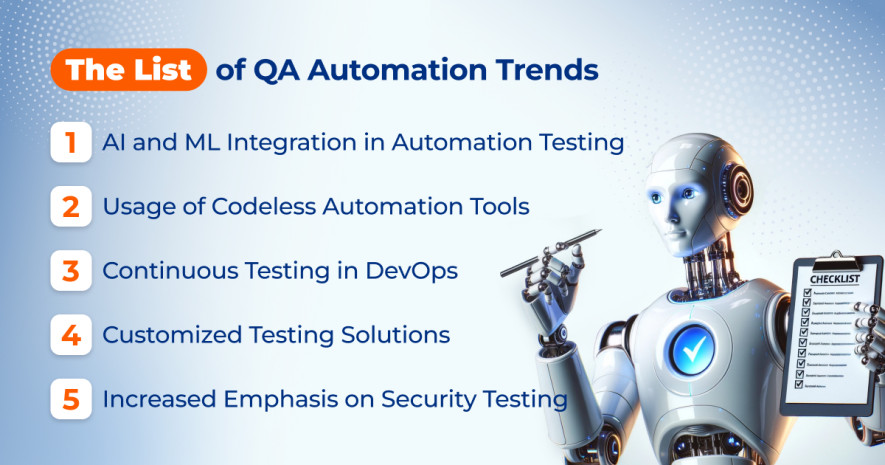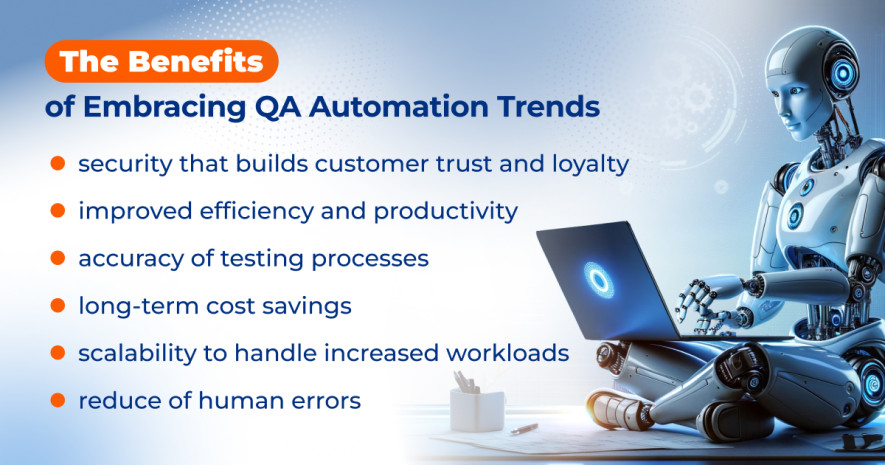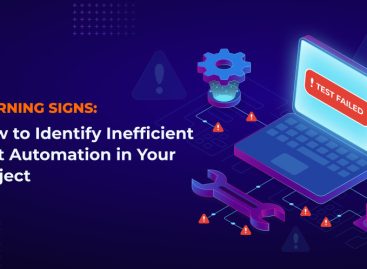- QATestLab Blog >
- Automated Testing >
- Top 5 QA Automation Trends in 2024 Era
The year 2024 is set to uncover the QA automation trends in 2024 that are more integrated, intelligent, and impactful than ever. Recent studies project a staggering 23% annual growth in test automation until 2024. This statistic is a testament to the increasing reliance on and trust in automation.

This article aims to delve deep into the trends, benefits, and opportunities that define the 2024 automation QA landscape. We will explore how businesses can leverage these advancements to optimize operations, enhance product quality, and stay ahead in the competitive digital arena.
Are you eager to learn more about how automation can transform your business in 2024 and beyond? Keep reading to uncover strategic approaches to automation that can bring your business to new heights. Join us on this journey into the future of automation and explore how our expertise at QATestLab can be your guiding force.
QA Automation Trends in 2024: Shaping the Future of Software Development
With the entering of a new decade, a significant transformation in QA automation is predicted. The trends highlight the growing importance of automation in delivering high-quality, efficient, and user-centric software solutions. Here, we explore the key trends in QA automation that are set to define the technological landscape in 2024.

1. AI and ML Integration in Automation Testing
Artificial Intelligence (AI) and Machine Learning (ML) are revolutionizing how we approach automation testing. In 2024, these technologies are expected to play a central role in making testing processes more intelligent and adaptive. AI and ML algorithms are employed to analyze test results, predict potential issues, and optimize testing strategies. This integration leads to smarter, more efficient, and more accurate testing processes, reducing the time and resources required for quality assurance.
2. Continuous Testing in DevOps
Continuous testing, integrated within the DevOps framework, is another trend gaining momentum in 2024. As organizations strive for faster development cycles and more frequent releases, continuous testing becomes crucial in ensuring that every release maintains a high-quality standard. This approach allows for immediate feedback and rapid correction of issues, fostering a more agile and responsive development process.
3. Usage of Codeless Automation Tools
Codeless automation tools are emerging as a game-changer, especially for teams that may lack extensive coding expertise. These tools are becoming more prevalent, offering user-friendly interfaces and drag-and-drop functionalities that simplify the creation and execution of automated tests. This trend democratizes automation testing, making it accessible to a broader range of professionals and allowing for quicker adaptation to changing testing requirements.
4. Increased Emphasis on Security Testing
With cyber threats becoming more sophisticated, security testing is taking center stage in QA automation. Automated security testing tools are becoming more advanced, capable of identifying vulnerabilities and potential threats with greater precision. In 2024, we see a trend towards integrating security testing into the early stages of the development cycle, ensuring that applications are not just functionally sound but also secure against emerging cyber threats.
5. Customized Testing Solutions
Finally, 2024 is witnessing a shift towards more customized and tailored testing solutions. Automation is no longer a one-size-fits-all approach; businesses are seeking solutions that align closely with their specific needs and challenges. Customized testing strategies are essential for addressing unique business requirements, ensuring that automation efforts are efficient, relevant, and effective.
These trends underline the evolving nature of QA automation in 2024, reflecting a shift towards more intelligent, inclusive, and security-focused testing practices. As we delve deeper into these trends in the subsequent sections, we will explore how they can be effectively implemented and what they mean for businesses looking to harness the power of automation in software development. Stay tuned to discover how these emerging trends can be leveraged to enhance your business’s operational efficiency and product quality.
Implementing QA Automation Trends in 2024 Effectively
As we witness the emergence of groundbreaking trends in QA automation, the question shifts from what these trends are to how they can be effectively implemented. The implementation of these trends requires a strategic approach, ensuring that they align with and enhance the specific goals and processes of each organization. Here are key strategies for effectively incorporating these QA automation trends into your business framework in 2024.
1. Integrating AI and ML for Smarter Testing
Integrating AI and ML into testing processes is a sophisticated attempt that necessitates a clear understanding of your software’s unique requirements. Start by identifying areas where AI can provide the most value, such as predictive analytics, test result analysis, and anomaly detection. Training your team on AI and ML tools or partnering with vendors specializing in AI-driven testing can significantly enhance your ability to leverage these technologies for more efficient and accurate testing outcomes.
2. Embedding Continuous Testing in Agile and DevOps Cultures
To capitalize on the benefits of Continuous Testing, it is vital to implement this approach within your existing Agile and DevOps frameworks. This involves automating as much of the testing process as possible and ensuring continuous integration and delivery pipelines are equipped with automated testing stages. Regular training and workshops can help teams adapt to this integrated testing approach, fostering a culture where testing is continuous, iterative, and an integral part of the development cycle.
3. Leveraging Codeless Automation Tools for Broader Accessibility
Adopting codeless automation tools is instrumental in making QA automation accessible to a broader team, including those with limited coding expertise. Select tools that offer intuitive interfaces and easy-to-use features, allowing team members to create, modify, and execute tests with minimal technical hurdles. Regular training sessions and workshops can help teams become proficient with these tools, ensuring they can quickly adapt to changes in testing requirements and maintain efficiency.
4. Prioritizing Security from the Start
Integrating security testing from the early stages of development is crucial. This means adopting tools and practices that can automatically scan code for vulnerabilities and ensure compliance with security standards. Creating a security-focused mindset within the development team is also key. Encourage collaboration between security experts and developers to build security into the software from the outset rather than treating it as an afterthought.
Successfully implementing these QA automation trends in 2024 requires a blend of the right tools, skilled personnel, and a strategic approach tailored to your organization’s needs. It is about creating an environment where automation is seamlessly integrated into every stage of the software development life cycle, reducing errors and ultimately leading to the creation of superior digital products.
Stay tuned for our next section, where we will explore the benefits of embracing these automation trends and how they can transform your business operations and product quality.
The Transformative Benefits of Embracing QA Automation Trends in 2024
Adopting the latest trends in QA automation can bring a multitude of benefits to your business, significantly transforming both your operations and the quality of the products you deliver. Here, we explore how embracing these automation trends can lead to substantial improvements in various aspects of your business.

One of the most immediate benefits of implementing advanced QA automation is the significant increase in efficiency and productivity. By automating repetitive and time-consuming testing tasks, teams can focus on more strategic aspects of product development. AI and ML-integrated tools enhance this efficiency by predicting and resolving potential issues before they escalate. This streamlined approach reduces the time-to-market, enabling businesses to respond more rapidly to market demands and customer needs.
Integrating AI and ML in QA automation leads to a notable improvement in the accuracy of testing processes. These technologies enable the identification of patterns and anomalies that might be missed by human testers. By reducing the likelihood of human error, automation ensures a higher level of consistency and reliability in test results, leading to the development of products with superior quality and performance.
As businesses grow, their testing needs become more complex and voluminous. Automation provides the scalability necessary to handle increased workloads without compromising quality or speed. Codeless automation tools, in particular, offer the flexibility to quickly adapt testing processes to new requirements or changes in the product, making it easier for businesses to scale and evolve their operations.
With cybersecurity threats on the rise, the importance of incorporating security testing from the early stages of development cannot be overstated. Automated security testing tools can continuously monitor applications for vulnerabilities, ensuring compliance with the latest security standards. This proactive approach to security not only protects businesses from potential breaches but also builds customer trust and loyalty.
While the initial investment in QA automation tools and training may be significant, the long-term cost savings are considerable. Automation reduces the need for manual testing, cutting labor costs and the expenses associated with human error. Over time, these savings can be substantial, making automation a cost-effective solution for businesses looking to optimize their operations financially.
Embracing the latest trends in QA automation positions your business for success in the dynamic digital landscape of 2024 and beyond. The benefits of improved efficiency, accuracy, scalability, security, and cost-effectiveness are transformative, paving the way for enhanced product quality and operational excellence. As we continue to explore the evolving world of automation, it becomes clear that adopting these trends is a strategic move and a necessary step towards future-proofing your business in the ever-competitive technology sector.
Summarizing the Trends and Taking Action
As we conclude our exploration of the transformative QA automation trends of 2024, it is evident that these advancements are not just fleeting shifts but are indeed reshaping the landscape of software development and quality assurance. From the integration of AI and ML to the rise of codeless automation tools, each trend represents a step forward in making software testing more efficient, accurate, and secure.
These trends underscore a fundamental truth: the future of successful software development hinges on the strategic implementation of automation. By embracing these trends, businesses can not only keep pace with technological advancements but can also gain a significant edge in terms of product quality, operational efficiency, and market responsiveness.
Now that you understand the significance and potential of these QA automation trends, the next step is clear. It is time to transform this knowledge into action. Whether you are just beginning to explore the possibilities of automation or looking to enhance your existing processes, QATestLab is here to guide you on this journey.
In 2023, QATestLab marked a significant milestone, experiencing a 40% surge in demand for our advanced automation solutions, a clear indicator of the shifting market dynamics towards more efficient QA processes. This expertise translated into tangible results, with our clients witnessing a 30% improvement in testing efficiency through our solutions. QATestLab, thus, stands not just as a service provider but as a strategic ally, guiding businesses toward a future where automation is integral to achieving a competitive edge and operational excellence.

Do not wait for the cutting-edge tomorrow to come to you. Take a proactive step towards embracing these automation trends and witness how they can revolutionize your business operations and product quality. Visit us at QATestLab – Request a Quote to get started. Our team is ready to collaborate with you to craft a customized automation strategy that aligns with your 2024 goals and beyond. Let’s create a future where quality and innovation go hand in hand.
Learn more from QATestLab
Related Posts:
- E-commerce in 2024: Which Trends to Implement?
- Software Testing in 2024: Innovations and Transformations
- Beyond Hours: Why Forward-Thinking Companies Choose Outcome-Based QA
About Article Author
view more articles







